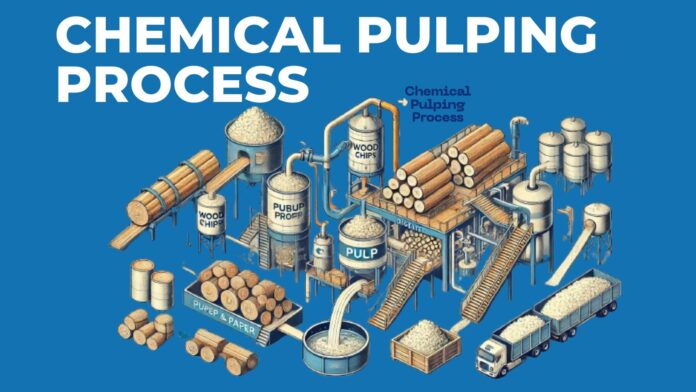The paper industry is a part of our daily lives. From newspaper and packaging materials to tissue and office supplies, there are many things that are related to the paper industry. The mechanical process takes most of the part of paper making, but the chemical pulping process in paper making plays an equally important role in the industry.
This method not only determines the quality of the paper but also ensures the efficient use of raw materials while maintaining eco-friendly practices. In this blog, we’ll explore the chemical pulping process in paper making in detail. We will discuss its necessity, the chemicals involved, and the types of paper produced using this method.
What is the Chemical Pulping Process in Paper Making?
Chemical pulping is a process that is used to separate lignin from cellulose fibers in wood or other plant materials. Here, lignin is an adhesive glue-like substance that binds the cellulose fiber together, making it necessary to remove it to achieve the required quality of pulp solution for paper production.
The mechanical pulping physically grinds wood, while the chemical pulping process in paper-making ensures a higher fiber yield, producing stronger, and more durable paper. This process also enhances the paper’s ability to absorb ink and resist tearing, making it ideal for a variety of applications.
The Steps of Chemical Pulping Process in Paper Making
The chemical pulping process involves many stages. Each stage is designed to break down wood into its essential components while preserving the cellulose fibers. Here are the stages involved in the chemical pulping process in paper making:
1. Chip Preparation
The debarked wood logs are cut into small chips to maximise their surface area for chemical penetration. These chips should be of proper size and the uniformity of these chips is important for efficient pulping. The chipping process is one of the initial and important processes in the paper-making.
2. Cooking
The wood chips are cooked in a pressure vessel called a digester, where they are mixed with a chemical solution. This stage, known as “digesting,” dissolves lignin and separates cellulose fibers. The cooking temperature and pressure are carefully controlled to ensure optimal fiber quality.
3. Washing and Screening
After cooking, the pulp is washed to remove residual lignin and cooking chemicals. Screening further separates any remaining wood fragments or impurities from the pulp.
4. Bleaching (Optional)
To produce white or bright-colored paper, the pulp undergoes a bleaching process. This step removes the last traces of lignin and enhances the pulp’s brightness.
Chemicals Used for the Chemical Pulping Process in Paper Making
The choice of chemicals depends on the specific pulping method, but the most commonly used include:
- Sodium Hydroxide (NaOH): Breaks down lignin during cooking.
- Sodium Sulfide (Na₂S): Enhances the removal of lignin in kraft pulping, for kraft paper manufacturing.
- Sodium Carbonate (Na₂CO₃): A key chemical in soda pulping.
- Chlorine Dioxide (ClO₂): Used in bleaching for producing white paper.
- Hydrogen Peroxide (H₂O₂): An eco-friendly bleaching agent.
Why is the Chemical Pulping Process Done?
The chemical pulping process offers several advantages over mechanical methods, making it a necessity in modern paper production:
- High-Quality Pulp: It produces stronger and more durable paper with superior printability.
- Preservation of Fiber Length: Chemical pulping minimizes fiber damage, resulting in higher-grade paper.
- Versatility: The pulp can be further processed into a wide range of paper products.
- Eco-Friendly Practices: Used chemicals can be recovered and recycled in most chemical pulping systems, reducing waste.
Types of Paper Produced Using the Chemical Pulping Process
The chemical pulping process is essential for producing various paper grades, including:
- Kraft Paper: Known for its strength, it is used in packaging, bags, and cartons.
- Bond Paper: High-quality writing and printing paper.
- Tissue Paper: Soft and absorbent, used for hygiene products.
- Cardboard: Strong and durable, ideal for industrial applications.
- Specialty Papers: Includes glossy, coated, and fine art paper.
Conclusion
The chemical pulping process in paper making is a cornerstone of the industry, ensuring high-quality paper with versatile applications. By effectively removing lignin while preserving cellulose fibers, this method allows for the production of durable, eco-friendly paper.
Its ability to cater to diverse needs, from kraft paper to fine writing materials, makes it an indispensable part of paper manufacturing.
As we continue to seek sustainable solutions, advancements in chemical pulping technologies promise an even more eco-conscious future for the paper industry. To know more about the paper industry, new advancements, and processes you can get in touch with us.
Understanding this process not only highlights its importance but also underscores the innovation driving modern manufacturing practices.


